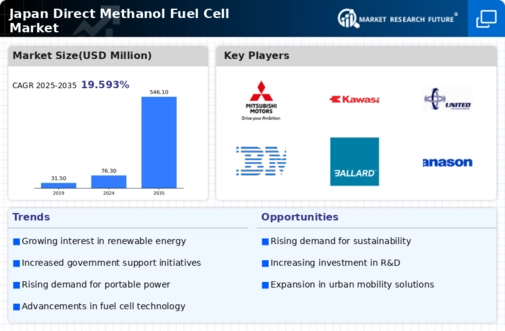Rising Energy Demand
The increasing energy demand in Japan is a pivotal driver for the direct methanol-fuel-cell market. As the nation seeks to diversify its energy sources, the adoption of fuel cells is gaining traction. The Japanese government has set ambitious targets to reduce greenhouse gas emissions by 46% by 2030, which necessitates a shift towards cleaner energy solutions. The direct methanol-fuel-cell market is positioned to benefit from this transition. It offers a viable alternative to traditional fossil fuels. Furthermore, the market is projected to grow at a CAGR of approximately 15% from 2025 to 2030, driven by the need for efficient energy solutions in residential and commercial sectors. This trend indicates a robust future for the direct methanol-fuel-cell market in Japan, as energy consumers increasingly prioritize sustainability and efficiency.
Environmental Regulations
Stringent environmental regulations in Japan are a driving force behind the direct methanol-fuel-cell market. The government has established rigorous standards aimed at reducing carbon emissions and promoting sustainable energy solutions. These regulations compel industries to adopt cleaner technologies, thereby increasing the demand for fuel cells. The direct methanol-fuel-cell market stands to gain from these regulatory pressures. Businesses seek to comply with environmental mandates. Moreover, the market is likely to benefit from the growing public awareness regarding climate change and the need for sustainable practices. As a result, the direct methanol-fuel-cell market could experience a growth trajectory of approximately 10% annually, reflecting the increasing emphasis on environmental responsibility.
Technological Innovations
Technological innovations play a crucial role in shaping the direct methanol-fuel-cell market. Japan is renowned for its advancements in fuel cell technology, with significant investments in research and development. The introduction of new materials and designs enhances the efficiency and performance of direct methanol fuel cells, making them more appealing to consumers. For instance, recent breakthroughs in catalyst development have improved the power density of these cells, potentially increasing their market adoption. The direct methanol-fuel-cell market is expected to witness a surge in demand. This surge will occur as these innovations lead to cost reductions and improved reliability. As a result, the market could see a growth rate of around 12% annually over the next five years, reflecting the impact of ongoing technological advancements.
Growing Industrial Applications
The growing industrial applications of direct methanol fuel cells are significantly influencing the market in Japan. Industries such as telecommunications, transportation, and backup power systems are increasingly adopting fuel cell technology due to its efficiency and reliability. The direct methanol-fuel-cell market is particularly well-suited for portable power applications. Traditional batteries may fall short in these scenarios. As industries seek to enhance operational efficiency and reduce downtime, the demand for direct methanol fuel cells is expected to rise. Market analysts project that the industrial segment could account for over 30% of the total market share by 2030, indicating a robust growth potential. This trend underscores the versatility and adaptability of direct methanol fuel cells in meeting diverse energy needs.
Government Incentives and Policies
Government incentives and policies are instrumental in propelling the direct methanol-fuel-cell market in Japan. The government has implemented various subsidies and tax incentives to encourage the adoption of clean energy technologies. For instance, the Ministry of the Environment has launched initiatives to promote fuel cell vehicles and stationary fuel cells, which directly benefit the direct methanol-fuel-cell market. These policies not only lower the financial barriers for consumers but also stimulate investment in infrastructure development. As a result, the market is projected to expand significantly, with estimates suggesting a potential increase in market size by 20% by 2030. This supportive regulatory environment is likely to foster innovation and enhance the competitiveness of the direct methanol-fuel-cell market.






















Leave a Comment